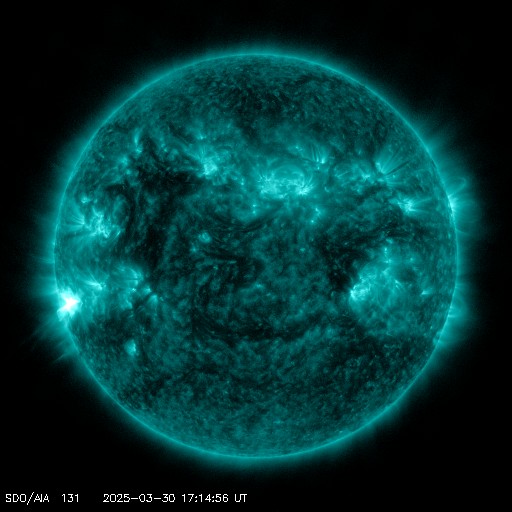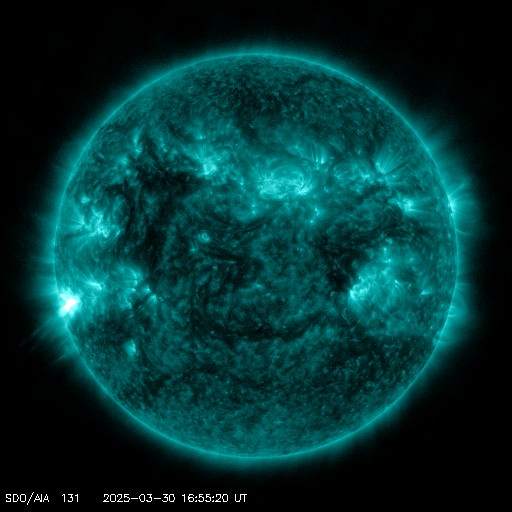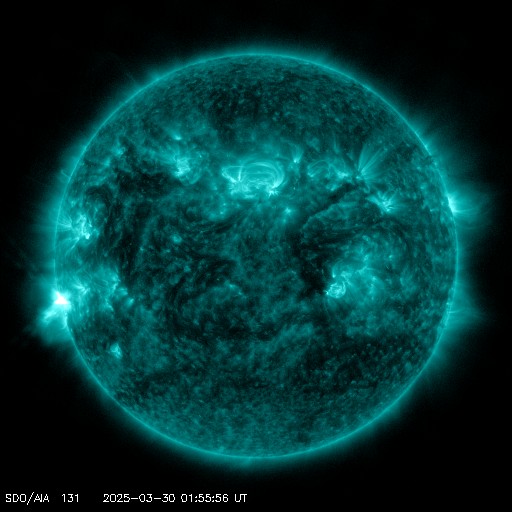Viewing archive of Sunday, 25 May 2003
Solar activity report
Any mentioned solar flare in this report has a scaling factor applied by the Space Weather Prediction Center (SWPC). Because of the SWPC scaling factor, solar flares are reported as 42% smaller than for the science quality data. The scaling factor has been removed from our archived solar flare data to reflect the true physical units.
Report of Solar-Geophysical Activity 2003 May 25 2200 UTCPrepared by the NOAA © SWPC and processed by SpaceWeatherLive.com
Joint USAF/NOAA Report of Solar and Geophysical Activity
SDF Number 145 Issued at 2200Z on 25 May 2003IA. Analysis of Solar Active Regions and Activity from 24-2100Z to 25-2100Z
Solar activity was at low levels. Region 368 (S33E37)
produced the largest event of the period, a C3.0/Sf flare that
occurred at 25/1754Z. This region exhibits a simple Hax alpha
magnetic structure. Region 365 (S08E08) has shown rapid growth
throughout the period in penumbral coverage and magnetic complexity.
Late in the period this region produced its first reported flare, a
B5.2 x-ray flare occurring at 25/2036Z. No new regions were
numbered today.
IB. Solar Activity Forecast
Solar activity is expected to be at
low levels. Region 365 has become capable of producing C-class
flares, if growth continues at this rate an isolated M-class flare
may be a possibility over the next 24-48 hours.
IIA. Geophysical Activity Summary 24-2100Z to 25-2100Z
The geomagnetic field was at quiet to minor storm levels. An
oscillating Bz component of the interplanetary magnetic field
allowed for two consecutive periods of minor storm conditions at
both the middle and high latitudes during local nighttime hours.
Elevated conditions are due to a high speed stream coronal hole.
The greater than 2 MeV electron fluxes at geosynchronous orbit
reached high levels today.
IIB. Geophysical Activity Forecast
The geomagnetic field is
expected to be at predominantly active levels through the forecast
period. Minor storm conditions are possible especially at local
nighttime hours. Isolated major storm intervals are possible on day
two of the period. The elevated activity is expected in
anticipation of yet another recurrent high speed stream coronal
hole.
III. Event Probabilities 26 May to 28 May
| Class M | 15% | 15% | 15% |
| Class X | 01% | 01% | 01% |
| Proton | 01% | 01% | 01% |
| PCAF | Green | ||
IV. Penticton 10.7 cm Flux
Observed 25 May 121 Predicted 26 May-28 May 125/125/120 90 Day Mean 25 May 125
V. Geomagnetic A Indices
Observed Afr/Ap 24 May 014/022 Estimated Afr/Ap 25 May 020/020 Predicted Afr/Ap 26 May-28 May 020/025-025/030-020/025
VI. Geomagnetic Activity Probabilities 26 May to 28 May
| A. Middle Latitudes | |||
|---|---|---|---|
| Active | 40% | 45% | 40% |
| Minor storm | 20% | 25% | 20% |
| Major-severe storm | 10% | 15% | 10% |
| B. High Latitudes | |||
|---|---|---|---|
| Active | 45% | 50% | 45% |
| Minor storm | 25% | 25% | 25% |
| Major-severe storm | 10% | 15% | 10% |
All times in UTC
Current data suggests there is a slight possibility for aurora to appear at the following high latitude regions in the near future
Rovaniemi, SodankyläKirkenes
Murmansk, Norilsk, Vorkuta
Latest news
Latest forum messages
More topicsSupport SpaceWeatherLive.com!
A lot of people come to SpaceWeatherLive to follow the Sun's activity or if there is aurora to be seen, but with more traffic comes higher server costs. Consider a donation if you enjoy SpaceWeatherLive so we can keep the website online!

Latest alerts
17:27 UTC - Solar flare
Moderate M1.5 flare
17:03 UTC - Solar flare
Moderate M1.61 flare
16:45 UTC - Radio Blackout
Minor R1 radio blackout in progress (≥M1 - current: M1.61)
02:09 UTC - Solar flare
Moderate M1.54 flare from sunspot region 4048
01:42 UTC - Radio Blackout
Minor R1 radio blackout in progress (≥M1 - current: M1.24)
Space weather facts
| Last X-flare | 2025/03/28 | X1.1 |
| Last M-flare | 2025/03/30 | M1.4 |
| Last geomagnetic storm | 2025/03/27 | Kp5 (G1) |
| Spotless days | |
|---|---|
| Last spotless day | 2022/06/08 |
| Monthly mean Sunspot Number | |
|---|---|
| February 2025 | 154.6 +17.6 |
| March 2025 | 127.5 -27.1 |
| Last 30 days | 127.5 -24.7 |





